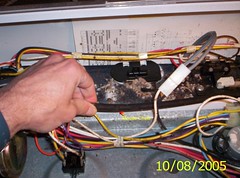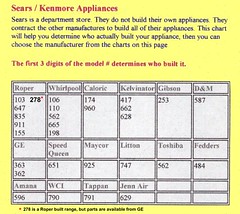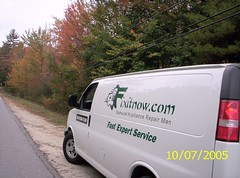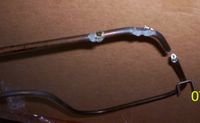SHI/U 43 MODELS
To start test program, press and hold both POWER SCRUB PLUS and REGULAR WASH program buttons, then turn unit on by pressing ON/OFF button. When program buttons are released, lights above them will flash. To end test program, press ON/OFF button.
To check each program indicator light, press its button.
To start testing, press both POWER SCRUB PLUS and REGULAR WASH buttons a second time. When testing has ended and a fault was detected, the following indicator lights will be lit:
WASH = Heater fault
RINSE/DRY = Water filling fault (over or under filling)
CLEAN = NTC (temperature sensor) fault ? note circulation motor stops shortly after it started during an NTC fault
To check for heater, high limit or flow switch problems, start testing until heating starts. Using a meter with a current coil, measure current going into dishwasher. If current is ~ 11 A, then heater, high limit and flow switch are OK. If current stays at ~ 1.5-2 A, then heater, high limit or flow switch are faulty.
If water level switch (f1) has failed (opened), RINSE/DRY light will come on and unit will continually fill and drain where testing won’t be completed. If flow switch (e5) has failed (opened), water won’t heat (to 150?F) and water won?t stop circulating. If NTC probe (f2/f4) has failed (opened), CLEAN light will come on immediately and testing will end shortly after water has started circulating.
If more than one fault occurs, more than one light will be lit.
SHU 4322 & 4326 MODELS
To start test program, press and hold both REGULAR WASH and RINSE & HOLD program buttons, then turn unit on by pressing ON/OFF button. Initially, control module version # will be displayed (e.g./ ?20? = version 0 without jumper). When wash program buttons are released, lights above them will flash. To end test program, press ON/OFF button.
To check each program indicator light, press its button. To check Cycle Countdown display, Refill Rinse Agent light and REGULAR WASH light, press REGULAR WASH button (press Delay Start button to test Cycle Countdown display alone). Cycle Countdown display will show “88” when REGULAR WASH button is pressed and “8h” when Delay Start button is pressed.
To start testing, press both the REGULAR WASH and RINSE & HOLD buttons a second time. When testing has ended, Cycle Countdown display will show a fault using codes below. If more than one fault occurs, code numbers will be added together, (e.g./ ?6? = faults 2 + 4).
0 = No faults detected 2 = Heating fault 8 = NTC (temperature sensor) fault
1 = Aqua Sensor (“Sensotronic”) fault 4 = Filling fault F = Filling fault (display occurs during wash, not test)
To check for heater, high limit or flow switch problems, start testing until heating starts. Using a meter with a current coil, measure current going into dishwasher. If current is ~ 11 A, then heater, high limit and flow switch are OK. If current stays at ~ 1.5-2 A, then heater, high limit or flow switch are faulty.
If water level switch (f1) has failed (opened), display will show fault code “4” and unit will continually fill and drain where testing won’t be completed. If flow switch (e5) has failed (opened), display will show “0”, water won’t heat (to 150?F) and water won?t stop circulating. If NTC probe (f2/f4) has failed (opened), display will show fault code “8” immediately and testing will end shortly after water has started circulating.
SHU 53 MODELS
To start test program, press and hold both SCRUB WASH and DELICATE/ECONO program buttons, then turn unit on by pressing ON/OFF button. Initially, control module version # will be displayed (e.g./ ?21? = version 1 with jumper). When wash program buttons are released, lights above them will flash. To end test program, press ON/OFF button.
To check each program indicator light, press its button. To check Cycle Countdown display, Refill Rinse Agent light and REGULAR WASH light, press REGULAR WASH button (press Delay Start button to test Cycle Countdown display alone). Cycle Countdown display will show “88” when REGULAR WASH button is pressed and “8h” when Delay Start button is pressed.
To start testing, press both the SCRUB WASH and DELICATE/ECONO buttons a second time. When testing has ended, Cycle Countdown display will show a fault using codes below. If more than one fault occurs, code numbers will be added together, (e.g./ ?6? = faults 2 + 4).
0 = No faults detected 2 = Heating fault 8 = NTC (temperature sensor) fault
1 = Aqua Sensor (“Sensotronic”) fault 4 = Filling fault F = Filling fault (display occurs during wash, not test)
To check for heater, high limit or flow switch problems, start testing until heating starts. Using a meter with a current coil, measure current going into dishwasher. If current is ~ 11 A, then heater, high limit and flow switch are OK. If current stays at ~ 1.5-2 A, then heater, high limit or flow switch are faulty.
If water level switch (f1) has failed (opened), display will show fault code “4” and unit will continually fill and drain where testing won’t be completed. If flow switch (e5) has failed (opened), display will show “0”, water won’t heat (to 150?F) and water won?t stop circulating. If NTC probe (f2/f4) has failed (opened), display will show fault code “8” immediately and testing will end shortly after water has started circulating.
SHI/U 68– MODELS
To start test program, press and hold both SCRUB WASH and DELICATE/ECONO program buttons, then turn unit on by pressing ON/OFF button. Initially, control module version # will be displayed (e.g./ ?20? = version 0 without jumper). When wash program buttons are released, lights above them will flash. To end test program, press ON/OFF button.
To check each program indicator light, press its button. To check Cycle Countdown display, Refill Rinse Agent light and REGULAR WASH light, press REGULAR WASH button (press Delay Start button to test Cycle Countdown display alone). Cycle Countdown display will show “88” when REGULAR WASH button is pressed and “8h” when Delay Start button is pressed.
To start testing, press both SCRUB WASH and DELICATE/ECONO buttons a second time. When testing has ended, Cycle Countdown display will show a fault using codes below. If more than one fault occurs, code numbers will be added together, (e.g./ ?6? = faults 2 + 4).
0 = No faults detected 2 = Heating fault 8 = NTC (temperature sensor) fault
1 = Aqua Sensor (“Sensotronic”) fault 4 = Filling fault F = Filling fault (display occurs during wash, not test)
To check for heater, high limit or flow switch problems, start testing until heating starts. Using a meter with a current coil, measure current going into dishwasher. If current is ~ 11 A, then heater, high limit and flow switch are OK. If current stays at ~ 1.5-2 A, then heater, high limit or flow switch are faulty.
If water level switch (f1) has failed (opened), display will show fault code “4” and unit will continually fill and drain where testing won’t be completed. If flow switch (e5) has failed (opened), display will show “0”, water won’t heat (to 150?F) and water won?t stop circulating. If NTC probe (f2/f4) has failed (opened), display will show fault code “8” immediately and testing will end shortly after water has started circulating.
SHV 43/48 MODELS
To start test program, press and hold both POWER SCRUB PLUS and REGULAR WASH program buttons, then turn unit on by pressing ON/OFF button. When program buttons are released, lights above them will flash. To end test program, press ON/OFF button. NOTE: TO ENABLE LIGHTS TO COME ON, DOOR MUST BE OPENED.
To check program indicator lights (POWER SCRUB PLUS, SCRUB WASH, REGULAR WASH and RINSE & HOLD), press and hold each program button. When SCRUB WASH program button is pressed, CLEAN and REFILL RINSE AGENT lights also come on (for SHV 4803 models) or CLEAN light also comes on (for SHV 4303 models). NOTE: TO ENABLE LIGHTS TO COME ON, DOOR MUST BE OPENED.
To start testing, press both POWER SCRUB PLUS and REGULAR WASH buttons a second time. When testing has ended and a fault was detected, the following indicator lights will be lit:
POWER SCRUB PLUS = Heater fault
SCRUB WASH = Water filling fault (over or under filling)
REGULAR WASH = NTC (temperature sensor) fault ? note circulation motor stops shortly after it started during an NTC fault
To check for heater, high limit or flow switch problems, start testing until heating starts. Using a meter with a current coil, measure current going into dishwasher. If current is ~ 11 A, then heater, high limit and flow switch are OK. If current stays at ~ 1.5-2 A, then heater, high limit or flow switch are faulty.
If water level switch (f1) has failed (opened), SCRUB WASH light will come on and unit will continually fill and drain where testing won’t be completed. If flow switch (e5) has failed (opened), water won’t heat (to 150?F) and water won?t stop circulating. If NTC probe (f2/f4) has failed (opened), REGULAR WASH light will come on immediately and testing will end shortly after water has started circulating. NOTE: TO ENABLE LIGHTS TO COME ON, DOOR MUST BE OPENED.
If more than one fault occurs, more than one light will be lit.
SHU 9902/9905/9906 (Millennium) MODELS
To start test program, press and hold both POWER SCRUB PLUS and REGULAR WASH program buttons, then turn unit on by pressing ON/OFF button. When program buttons are released, lights above them will flash. To end test program, press ON/OFF button.
To check program indicator lights (POWER SCRUB PLUS, SCRUB WASH, REGULAR WASH and RINSE & HOLD), press and hold each program button. When SCRUB WASH program button is pressed, CLEAN light also comes on.
To start testing, press both POWER SCRUB PLUS and REGULAR WASH buttons a second time. When testing has ended and a fault was detected, the following indicator lights will be lit:
POWER SCRUB PLUS = Heater fault
SCRUB WASH = Water filling fault (over or under filling)
REGULAR WASH = NTC (temperature sensor) fault ? note circulation motor stops shortly after it started during an NTC fault
To check for heater, high limit or flow switch problems, start testing until heating starts. Using a meter with a current coil, measure current going into dishwasher. If current is ~ 11 A, then heater, high limit and flow switch are OK. If current stays at ~ 1.5-2 A, then heater, high limit or flow switch are faulty.
If water level switch (f1) has failed (opened), SCRUB WASH light will come on and unit will continually fill and drain where testing won’t be completed. If flow switch (e5) has failed (opened), water won’t heat (to 150?F) and water won?t stop circulating. If NTC probe (f2/f4) has failed (opened), REGULAR WASH light will come on immediately and testing will end shortly after water has started circulating.
If more than one fault occurs, more than one light will be lit.
SHU 991x/992x (Integra) MODELS
To start test program, press and hold both POWER SCRUB PLUS and REGULAR WASH program buttons, then turn unit on by pressing ON/OFF button. When program buttons are released, lights above them will flash. To end test program, press ON/OFF button.
To check program indicator lights (POWER SCRUB PLUS, SCRUB WASH, REGULAR WASH and RINSE & HOLD), press and hold each program button. When SCRUB WASH program button is pressed, CLEAN light also comes on andan audible tone (?beep?) also occurs.
To start testing, press both POWER SCRUB PLUS and REGULAR WASH buttons a second time. When testing has ended and a fault was detected, the following indicator lights will be lit:
POWER SCRUB PLUS = Heater fault
SCRUB WASH = Water filling fault (over or under filling)
REGULAR WASH = NTC (temperature sensor) fault ? note circulation motor stops shortly after it started during an NTC fault
To check for heater, high limit or flow switch problems, start testing until heating starts. Using a meter with a current coil, measure current going into dishwasher. If current is ~ 11 A, then heater, high limit and flow switch are OK. If current stays at ~ 1.5-2 A, then heater, high limit or flow switch are faulty.
If water level switch (f1) has failed (opened), SCRUB WASH light will come on and unit will continually fill and drain where testing won’t be completed. If flow switch (e5) has failed (opened), water won’t heat (to 150?F) and water won?t stop circulating. If NTC probe (f2/f4) has failed (opened), REGULAR WASH light will come on immediately and testing will end shortly after water has started circulating.
If more than one fault occurs, more than one light will be lit.
SHU 33 MODELS
To start test program, press and hold both POWER SCRUB PLUS and RINSE & HOLD program buttons, then turn unit on by pressing ON/OFF button. When program buttons are released, lights above them will flash. To end test program, press ON/OFF button.
To check program indicator lights (POWER SCRUB PLUS, REGULAR WASH and RINSE & HOLD), press and hold each program button. When REGULAR WASH program button is pressed, CLEAN light also comes on.
To start testing, press both POWER SCRUB PLUS and RINSE & HOLD buttons a second time. When testing has ended and a fault was detected, the following indicator lights will be lit:
POWER SCRUB PLUS = Heater fault
REGULAR WASH = Water filling fault (over or under filling)
RINSE & HOLD = NTC (temperature sensor) fault ? note circulation motor stops shortly after it started during an NTC fault
To check for heater, high limit or flow switch problems, start testing until heating starts. Using a meter with a current coil, measure current going into dishwasher. If current is ~ 11 A, then heater, high limit and flow switch are OK. If current stays at ~ 1.5-2 A, then heater, high limit or flow switch are faulty.
If water level switch (f1) has failed (opened), REGULAR WASH light will come on and unit will continually fill and drain where testing won’t be completed. If flow switch (e5) has failed (opened), water won’t heat (to 150?F) and water won?t stop circulating. If NTC probe (f2/f4) has failed (opened), RINSE & HOLD light will come on immediately and testing will end shortly after water has started circulating.
If more than one fault occurs, more than one light will be lit.









